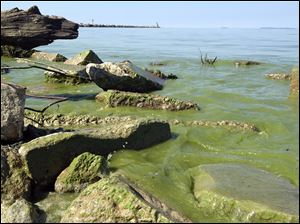
Algae scientist says nitrogen another issue
Efforts have been made to limit phosphorous in lake
4/1/2017One of the Great Lakes region’s top algae scientists told 70 people in Perrysburg on Friday there needs to be a more concerted effort to limit nitrogen — not just phosphorus — from area waterways to keep deadly blooms from forming.

Lake Erie algae along the shoreline during the summer of 2014.
Policymakers are often laser-focused on phosphorus because it is considered the primary driver behind the size of algae mats. Ohio, Michigan, and Ontario have pledged a 40 percent reduction in phosphorus loading into the western Lake Erie basin by 2025, without setting a similar goal for nitrogen.
But Tim Davis, molecular harmful algal bloom ecologist for the National Oceanic and Atmospheric Administration’s Great Lakes Environmental Research Laboratory in Ann Arbor, said at Friday’s annual Lake Erie Waterkeeper conference the evidence is mounting that nitrogen is the biggest factor for a bloom’s toxicity.
And, he noted, toxicity — not size — is more important when it comes to public health.
“While phosphorus concentrations are very important for bloom size, nitrogen concentrations are important for bloom toxicity,” Mr. Davis said at the event, held at the W.W. Knight Nature Preserve that’s part of the Wood County Park District. “When nitrogen’s low, toxicity’s low.”
Exact correlations are not known. Microcystis, the dominant form of algae in western Lake Erie, is one of Earth’s oldest organisms at 3.5 billion years old and has been on the rise globally. Yet research into it is still in its infancy by scientific standards, with only about 40 years of data available, Mr. Davis said.
“We’ve been studying them for over 40 years and we’re still learning,” he said.
But the case is getting stronger that policymakers need to look harder at nitrogen without losing sight of phosphorus when considering rules to limit nutrients, he said.
“It’s a dual nutrient issue in the Great Lakes, as well as the Chesapeake Bay,” Mr. Davis said.
Even with the Trump administration’s attempt to gut Great Lakes programs — something several members of Congress from both parties have vowed not to let happen — plans for better Lake Erie monitoring are moving forward.
A large, stationary device called the ESPniagara — which Mr. Davis describes as a “laboratory in a can” — will be deployed by NOAA again this June to October near the Toledo water intake, as it was last summer when it was deployed for the first time in fresh water.
At 5 feet, 6 inches tall, the device is the size of a human.
One of only a few in the world, it is unique in that, by using robotics, it can take its own water samples and do tests on them under water. Real-time results are transmitted to scientists from beneath the lake.
Developed by the Monterey Bay Aquarium Research Institute south of San Francisco for oceanic research, the device is in its second generation. NOAA’s Great Lakes lab expects to get a second one for western Lake Erie this summer while Monterey Bay Aquarium researchers run tests on the next generation — an underwater robotic device that is mobile. The latter could be deployed in western Lake Erie in 2018, Mr. Davis said.
Scientists also now believe microcystin — an algal toxin produced by microcystis and at least two other types of algae — lingers three to 14 days after blooms dissipate.
“Just because there is no bloom doesn’t mean there is not toxin,” Mr. Davis said. “If you’re in the western basin, just be mindful that if there had been a recent bloom, there still could be toxins.”
The latest Waterkeeper conference also touched on issues ranging from livestock manure-spreading in the western Lake Erie and Chesapeake Bay regions to the latest on efforts being undertaken by the Toledo Zoo and others to re-establish iconic lake sturgeon in the Maumee River.
Kent Bekker, Toledo Zoo conservation director, said the zoo will set up a trailer near the Maumee and convert it io a streamside nursery to begin rearing baby sturgeon this year.
A year from now, in the spring of 2018, it hopes to have the first of what could be many years of releases.
It is working in collaboration with others, including the U.S. Fish and Wildlife Service, the University of Toledo, and Lake Erie Waterkeeper on the project.
Sandy Bihn, Lake Erie Waterkeeper founder, said the goal is to instill pride in the muddy Maumee by getting people excited about sturgeon releases.
Lake sturgeon are as old as dinosaurs, can grow to 12 feet long, and are strong enough to knock down humans. They are the largest Great Lakes fish.
Contact Tom Henry at: thenry@theblade.com, 419-724-6079, or via Twitter @ecowriterohio.